















|
South to Kuala Lumpur and Singapore
by Gary Hacker
Rusty has combed almost every city in Southeast Asia and has uncovered their innermost secrets. When he asked my friend Bob and I to accompany him on a visit
to Singapore and Kuala Lumpur, we jumped at the chance. We call Rusty “The Shadow”; originally from Atlanta, Georgia, he has spent years traveling through Asia and his
magnetic personality and great sense of humor make him the perfect guide to uncover hidden places in foreign cities.
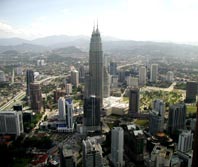 The Menara Tower features a public
observation platform with dynamic views over the entire city. The Menara Tower features a public
observation platform with dynamic views over the entire city.
We left Bangkok on Swiss Air, according to Rusty a cheap link to Singapore and only a two-hour flight (Baht 5,000rt). The new Singapore Airport is huge and
an adventure in itself. So many duty free shops and tiny places to eat, we made a mental note to arrive early for our return flight. Taxis carry an airport surcharge and extra
charges for the commute hours. We checked into the Tai Hoe Hotel in the Indian Quarter of Singapore, close to downtown and to the discount electronic warehouses. The Tai Hoe
offers special rates for Internet reservations (s$58) and although the rooms are small, they are bright and clean. Tap water in Singapore is clean and safe to drink. The
current exchange rate is Singapore $1.74 to one US Dollar.
Our first stop of the evening was to sip a drink at the Long Bar at the famous Raffles Hotel. The courtyard and common areas are extravagant and the center
garden offers a place to relax and chat. For dinner, we headed for a little known Chinese restaurant next to the tall Sim Lim Center, a complex specializing in everything
electronic. Unpretentious with straight back chairs and Formica tables, the mouth-watering aroma of Asian spices and food saut้ing on many pans, drew us to the entrance.
(Sun Chui Yuen Restoran) Rusty ordered an elaborate spread of exotic cuisine and we dug in with gusto savoring every morsel. We left too full to even think of desert; following
“The Shadow”, we proceeded down some dark alleys to a small below level bar filled with happy locals enjoying a wide array of beers and Asian tidbits. It was almost
midnight and with eyes drooping, we headed back to our hotel.
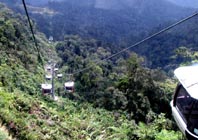 Tramway up to the majestic heights
of Genting Highlands Tramway up to the majestic heights
of Genting Highlands
The next day was spent at Sim Lim Center, looking at stereo components and comparing prices to Thailand. The Center is a wonderland of hand phones, hi-fi
stuff and computer accessories. I found a sought after CD burner at an amazingly low price and Bobby discovered some strong self powered speakers at an excellent value. Rusty
had his own errands and Bobby and I were left to wander around the city and shop in the local malls and specialty shops. Aside from electronics, we found Singapore to be more
expensive overall than Thailand and definitely lacking the smiles. That evening, we were taken to a most unusual restaurant. The Red Book (or House of Mau) is like stepping
into China; the d้cor features paintings of Mau and large murals of Tienemen Square depicting communist teachings. The bar offered an array of cocktails and the food was
delicious. A very unusual atmosphere and worth seeing. (51 Telok Ayer St.)
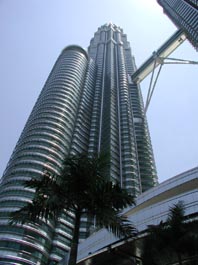 The twin Petrona Towers dazzle in
the sunlight The twin Petrona Towers dazzle in
the sunlight
The same night we experienced one of the most superlative adventures of our trip. Rusty led us to the worlds only “Night Safari”, a jungle of nocturnal
animals in their natural environment located about 35 minutes out of town. Under the magical night sky with the moon and stars above, we embarked down a trail with just enough
lighting to discover the many unusual and unknown species of animals, most at very close range. Paths wind through the dense foliage built through the vastness of a national
wildlife park and the darkness magnifies all six senses resulting in a nature walk that will be long remembered. A tram is available for the less adventurous but does not
include many of the dark corners and dimly lit forest scenes. The walk is about 1.7 kilometers, all fairly level, but seems much shorter. A large brown bear emerged from behind
a tree and several tigers with their cubs lounged just feet from the footpath. As we passed a small creek full of boa constrictors, I tickled Rusty’s bare ankle with a long
stick and he screamed with shock and jumped high in the air to everyone’s delight.
An interesting place to wander in the afternoon is along Clarke Quay next to the Singapore River. There are numerous small bars and nightclubs that cater to
the young crowd, among those “The Crazy Elephant”, “The Blues & Booze” and the “The Rachet”. Rusty’s favorite was the “Black Penny” where we had delicious
“Bacon Toasties”, thin-cut grilled French bread with crisp bacon and tomato covered with slices of melted Swiss cheese, yum. Another great find was “Spageddies Italian
Kitchen” located out in Tanglin Mall about a 20-minute taxi ride from City Center.
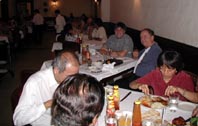 Enjoying the delicious steaks at
the Coliseum Cafe Enjoying the delicious steaks at
the Coliseum Cafe
The following days were spent roaming around Singapore exploring unknown shops and restaurants that Rusty had found on earlier trips. A modern people mover
is the MRT underground, extremely fast with a train every few minutes. Fares range from s$.70 to s$1.60.
A few days later, we departed on the Kuala Lumpur-Singapore Express, an early morning bus for a six-hour trip to Kuala Lumpur, Malaysia (s$25). This bus has
only three large seats across and good picture windows for viewing the passing roadside and small cities. We arrived in Kuala Lumpur in the early afternoon and checked into the
Fortuna Hotel, another one of our leader’s great finds. The city was a big surprise to both Bobby and me. We had pictured it as a step down from Bangkok but the unusual
architecture and wide streets with good traffic flow were a cut above anything in Thailand.
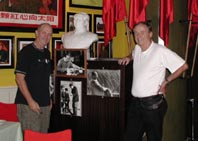 The Red Book (or House of Mau) is
like stepping into China The Red Book (or House of Mau) is
like stepping into China
Kuala Lumpur is a city of magnificent high-rises, each one different and a masterpiece of architecture. The twin Petrona Towers dazzle in the sunlight and
reflections from their bright silver exterior distinguish them from all others. The shopping malls try to outdo each other with tall columns and cut glass ceilings with
pinpoints of light along the tiers of trendy shops. Sidewalks are crowded with busy shoppers and walkways cross under the busy streets or connect the malls with high flyovers.
The rapid transit system is clean and efficient and the four legs of the line cover most of the city. Even the underground loading platforms are air-conditioned.
The Fortuna Hotel is located in the center of town within walking distance to most attractions. Rusty bargained for a rate of 102 Ringgits (about US$27)
including breakfast and the spacious rooms had bathtubs and elegant wood trim. The Fortuna, like most local hotels, features a “health club” that offers various massages
and baths; however, Pattaya has spoiled us and we found the prices for the services to be far above what we are used to paying.
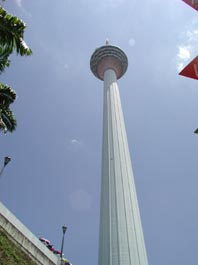 Looking up at the Menara Tower Looking up at the Menara Tower
There are a number of restaurants near the hotel and one is called “The Ship” at #1 Scotts Road. Prices are reasonable and the atmosphere and food were
tops. Internet services abound but it takes some tries to find one with efficient computers. Just around the corner from the hotel and upstairs we found a jewel with quick
machines for 4 Ringgits an hour.
Our first day in Kuala Lumpur we elected to visit “The Menara Tower”, a spectacular landmark in the center of the city. At 421 meters above the ground,
it is one of the tallest concrete towers in the world. The structure was built in 1996 to enhance the quality of communications and the Tower Head features a public observation
platform with dynamic views over the entire city. We took one of the four elevators to the top and our ears plugged and popped during the rapid ascent. A fire had broken out in
a residential area to the East and we watched as fire equipment rushed across town and we could see the flames as they broke through the roofs of the structures. The views were
stupendous and I was glad to establish the city boundaries before we began our exploration.
We set out on foot and walked along tree-covered streets and through freshly landscaped parks and along the narrow streets of Chinatown. We recognized an
enchantment about the city, the air was fresh, the sun shone brightly overhead and we walked late into the afternoon before returning to the hotel. By the way, the current
exchange rate in KL is 3.8 Ringgits to US$1 making everything quite reasonable.
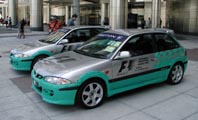 Promoting the Petronas F1
Malaysian Grand Prix Promoting the Petronas F1
Malaysian Grand Prix
There are flashy franchised American restaurants on the street corners of Jalan Sultan Avenue and we elected to sample some tidbits at cocktail time,
settling for mediocre appetizers and expensive drinks. We found the local Malay food far more appealing.
A bright sunny morning and we negotiated with a taxi (Rg70) to take us out of town and up to the majestic heights of Genting Highlands. Rusty had discovered
a dazzling casino complex atop a towering mountain and a tramway carried us the rest of the way across majestic canyons to a platform high above the terrain. We had lunch at
the Friendship Chinese Restaurant and nibbled at trays of Dim Sum and sipped large glasses of Chinese tea. The views are overwhelming. The casino is huge with colored lighting
and busy tables in each of four large areas. We had to rent batik shirts for Rg3 in order to gain entrance. The roulette and blackjack tables stretched as far as we could see.
The gambling spirit was intoxicating but we made our small contribution and left before suffering any sizeable losses. We took the tram back down the mountain and caught a tour
bus to town. We got off at an early stop on Jalan Tuanku Abdul Rahman to visit the Coliseum Caf้ and Hotel that Rusty had discovered on his last trip. The historic
structure was built in 1921 and is well known among the locals of the city. The bar d้cor is magnificent. The old wood paneling and high ceilings date back to a period
long forgotten. After sipping cocktails and nibbling some mouthwatering onion strings, we decided to adjourn to the long rectangular restaurant and try one of the Coliseum’s
famous steaks. Overseeing the white linen covered tables were crisp dressed waiters in white starched shirts and black ties. We weren’t disappointed, as the steaks were
served on sizzling black platters with an unusual dark gravy that enhanced the tender beef. Platters of roast potatoes and crisp fresh vegetables covered our table.
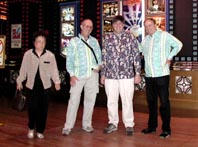 We had to rent batik shirts for Rg3
in order to gain entrance to the casino We had to rent batik shirts for Rg3
in order to gain entrance to the casino
A few days later it was time for Bobby and I to leave the city and make our way back to Singapore for our return flight to Bangkok. Rusty was flying back to
the States from Kuala Lumpur so we elected to take the train back to Singapore. First Class train fare was 68 Ringgit giving us wide seats with footrests and excellent air con.
The scenery was different from road travel and we captured the backcountry, creeks and streams and isolated ranches and villages along the railway. We arrived in time to meet a
friend of Bobby’s who lived in Singapore and took us to an out-of-the-way seafood restaurant. Located down an alley and on the fourth floor of a residential building, it
featured a romantic atmosphere and a wide selection of fresh fish. The following day we left on our flight to Bangkok and sipped wine as we talked about Singapore and Malaysia
and our intention to return again one day soon.
The Olympic Peninsula, Washington State’s Natural Treasure
by Chalerm Raksanti
On a clear day, the Olympic Mountains, rising out of their fog bank, are easily seen from the streets of the American city of Seattle, 40 miles to the
east. But when one looks back toward Seattle from this wild country, the metropolis seems very distant. Here on the Olympic Peninsula of the USA’s western shores,
Washington State’s northeast corner resounds with the primeval energy of a wilderness untamed. From the pounding of the surf of Pacific beaches, to lush rain forests,
profound respect for nature still reigns.
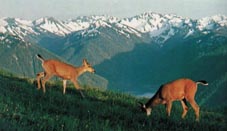 Deer range free in the valleys
below the timber line Deer range free in the valleys
below the timber line
There is a swagger of self-confidence in the people who reside on this thumb of land which nudges into the Pacific Ocean from the edge of the continent. It
comes from besting nature in her wildest exuberance. Beneath the Pacific marine layer of fog which shrouds both coast and forest, one finds some of the world’s tallest
trees, the fattest salmon, most exotic coastline, wettest weather, and mountains so rugged they seem the frigid home for gods.
Of course, the peninsula is no longer truly mysterious. Millions of visitors make their way here each year. Still, there is wilderness enough, as seen from
deep in the backwoods of the Olympic National Park. And the Douglas Fir is the kind of tree which makes your hat fall off when you throw your head back to see the top.
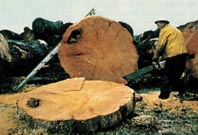 Huge spruce logs being trimmed
in a yard near Forks, WA Huge spruce logs being trimmed
in a yard near Forks, WA
By dodging huge logging trucks which grind their way along the two-lane track of the Olympic Loop Highway, it is possible to complete the circuit of this
6,500 square mile peninsula in a single day. But who would want to rush through this pride of the Pacific Northwest? In its northwestern corner, called the West End, a
traveller wanders into remote timber towns, elegantly named Sappho, and less elegantly, Forks. The West End is wild, woodsy, thinly settled. The road runs down hushed aisles
of lofty Douglas fir, hemlock and Sitka spruce, and passes through deadened stretches of clear-cut forest, forlorn and empty. But from every side of the peninsula, its crown
jewel, the mountainous 900,000 acre Olympic National Park is visible, veined with snow and glacier ice, even in July. Along the edges, a patchwork of alpine wildflowers
bloom. Six hundred miles of hiking trails grace this national wilderness, and the interior is accessible in many places only on foot. Set aside by the US Congress in 1938,
this park includes a 50 mile long stretch of wild and scenic beach. Nine American Indian reservations control an additional 162,00 acres.
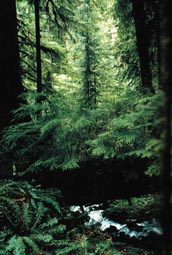 Rainforest on Olympic Peninsula Rainforest on Olympic Peninsula
An immense rain trap for the moist Pacific winds that buffet their windward slopes, the Olympic Mountains divide the peninsula into contrasting zones.
While rainfall in excess of 140 inches per year nourishes luxuriant temperate rain forest along the valleys of the Hoh, Queets, and Quinault Rivers, a rain shadow casts the
northeast side into relative dryness, demanding occasional irrigation of farms in this area.
Off the coast the Pacific breathes in mammoth swells. Due north, Vancouver Island lies ten miles across the Strait of Juan de Fuca. To the east glitters
Hood Canal (a fjord dug deep by glaciers), Puget Sound, and a cluster of quiet inlets which are breeding grounds for the world’s rarest and tastiest oysters.
The peninsula’s oldest town, Port Townsend was originally built on tide-land in the northeast corner of the region. Settled by sea captains and merchants
from New England, it has the look of America’s eastern seaboard about it. Vast Victorian houses and gracious inns, turreted and gingerbready, the chief economy here is
tourism. At the end of the 19th Century, Port Townsend laid great plans to build a rail spur to join the Union Pacific at Portland, Oregon. Dreams of becoming a premier port
were dashed when the deal collapsed, and the established line linking Seattle and Tacoma on the east side of the Puget Sound took the traffic. Now, Port Townsend is a centre
for artists and musicians, a town populated with unconventional people deserting the hassle of urban life.
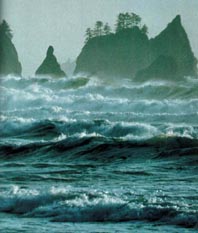 Banked in fog, surf pounds
Pacific beaches on Washington State’s Olympic Peninsula Banked in fog, surf pounds
Pacific beaches on Washington State’s Olympic Peninsula
From Port Townsend westward, the Strait of Juan de Fuca cuts a broad, blue-green channel nearly a hundred miles to the Pacific Ocean. This is a truly
magnificent waterway, 14 miles wide at the mouth, and deep enough to allow the US Navy’s big submarines easy access to their base on the Hood Canal. The Pacific, streaming
into the strait throws everything from whales to World War II mines onto the beaches. Wandering across these wide, endless stretches of sand, a beachcomber will find hundreds
of logs, scoured by the waves, stacked and bleached by the sun. These logs are escapees from the booms - the big floating islands of timber en route from forest to market.
Sometimes the logs escape from their chains, float away, and are washed up on the beach. On the park’s western border, it is possible to walk through the rain forest. That
quirk of nature which dumps rivers of rainfall in this area will turn crops to dust just 40 miles over the other side of the mountains.
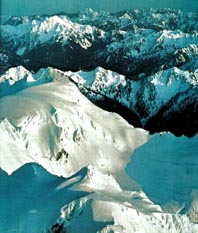 The jagged peaks of the Olympic
Mountains The jagged peaks of the Olympic
Mountains
Logging on the peninsula is a controversial industry. The Untied Nations Educational, Scientific, and Cultural Organisation, (UNESCO) has listed the
Olympic National Park as one of its 165 World Heritage Sites, together with the Pyramids, the Galapagos Islands, and the Taj Mahal. But there are others who view the park and
its federal managers more darkly. People who make their living cutting and marketing timber angrily feel the government has grabbed land which belongs to them. Despite the
boom and bust cycles, timber is clearly a mainstay of the economy on the Olympic. Men who work in the woods wear the traditional logger’s uniform; red suspenders, striped
shirt, denim pants cut off at mid calf to prevent snagging on the underbrush, and high top calk boots.
But where no axe has been raised in the luxuriance of the Olympic rain forest, wind-toppled trees provide nourishment for saplings, while moss and ferns
feed on the very air. As the locals claim, this is God’s country. The natural solitude and the almost stubborn adherence of some of the residents to nature’s more
deliberate rhythms, keep this wilderness an unmatched treasure.
French Invasion
The first French Film Festival in Pattaya was held last weekend, commencing with a cocktail reception at Espace Francophone. Organiser, Georges said that
the seven movies that were brought to Pattaya’s screens were all nominations for Caesar awards, the French equivalent of the Oscars, and he hoped that next year the Film
Festival would run for one week with a correspondingly larger number of films.
 (L to R) Pierre de Fraisinette
Honorary French Consul), Christelle Delfolaie (Echo du Siam), Philippe Borg (Echo du Siam) and Georges Langlois (organizer) at the cocktail reception to introduce the first
Pattaya French Film Festival. (L to R) Pierre de Fraisinette
Honorary French Consul), Christelle Delfolaie (Echo du Siam), Philippe Borg (Echo du Siam) and Georges Langlois (organizer) at the cocktail reception to introduce the first
Pattaya French Film Festival.
With English subtitles, the films’ appeal were greater than just for the Francophiles, and many nationalities were seen streaming into the two theatres
at the Royal Garden Plaza and Big C.
The most popular screening was the Gerard Depardieu farce “Asterix et Obelix contre Cesar” which was a wonderfully refreshing and humorous film.
Stress Seminar well attended
The Bangkok Pattaya Hospital’s seminar on Stress in Thailand held last weekend was very well received by the people attending. The panel of Bangkok based
German psychologist Dominique Norz and Dr Iain Corness were assisted by Dr Jonathan Corness (Australia) and Dr. Supoj (Thailand) with moderation from Walter Jack Heller.
 (L to R) Dr Jonathan Corness,
Walter Jack Heller, German psychologist Dominique Norz and Dr Iain Corness. (L to R) Dr Jonathan Corness,
Walter Jack Heller, German psychologist Dominique Norz and Dr Iain Corness.
Much spirited discussion took place after the didactic opening session and it was decided to form a ‘Support Group’ for those who felt they could
benefit from this. Neera Sirisampan from the International Department of the Bangkok Pattaya Hospital has said she would organise this, and she can be contacted on (038) 427
777.
Rotary District 3350 holds conference in Pattaya
Pattaya played host to thousands of Rotarians from around Thailand last week beginning with the district conference of District 3340 and the Rotary Fair.
This most successful week of service to the community culminated with R.I. District 3350’s District Conference at PEACH in the Royal Cliff Beach Resort last weekend.
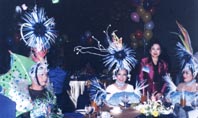 There’s no business like show
business There’s no business like show
business
This time almost a thousand Rotarians from District 3350 converged on Pattaya to meet in fellowship and to learn and plan for more projects in their
untiring work to help the underprivileged. Members of the Rotary Club of Phnom Penh also attended. This club is the first Rotary Club in Cambodia and will be embraced into
District 3350.
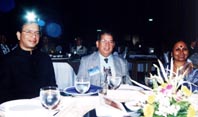 PDG R.K. Ravendran and Mrs.
Ravendran flank District Governor Chow Nararidh on opening night. PDG R.K. Ravendran and Mrs.
Ravendran flank District Governor Chow Nararidh on opening night.
District Governor Chow said that this conference was not going to be a dull affair of meetings, but that it would have a friendly carnival atmosphere about
it. And a carnival it was with the International Fancy Night celebrated on the closing evening. PDG R.K. Ravendran from the Rotary Club of Colombo, attending in his capacity
as the personal representative of R.I. President Frank Devlyn, was so impressed by the way Rotarians organised meetings that he exclaimed, “You Rotarians really know not
only how to work hard but also how to have fun.”
Happy Birthday, Momi!
It is rather seldom in Europe for someone to celebrate their 90th birthday in good health and spirit. And it is very rare in Thailand for a farang lady to
celebrate this remarkable birthday here. However, Mrs. Klara von Geiso, born on March 24th 1911 in Germany, did just that.
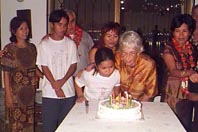 Klara gets help from her
granddaughter Rainy to blow out the candles while the other family members look on. Klara gets help from her
granddaughter Rainy to blow out the candles while the other family members look on.
Mrs. Klara spent most of her life in Hamburg, but 2 1/2 years ago she came to Pattaya to visit her son, Achim von Geiso. Falling in love with the place
and, of course, wanting to be near her son, she decided to stay here for good.
Now at the age of 90, she is still very energetic, likes to go on shopping sprees and goes swimming every day in the swimming pool of Achim’s house in
Flower Park.
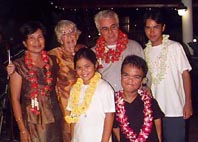 The birthday lady surrounded by
her family: son Achim, his wife Wilawan and their three children, Aroon, Aram and Rainy. The birthday lady surrounded by
her family: son Achim, his wife Wilawan and their three children, Aroon, Aram and Rainy.
Sometimes she feels like having a break and travels to Koh Samui, but usually its too boring there for her to stay very long. One can understand why, since
Mrs. Klara entertains many more visitors here, all of whom are happy that she lives a comfortable and fulfilling life in Pattaya with her son and his family.
A 90th birthday needs a proper celebration, and Achim von Geiso did everything possible to make his mother’s birthday party a big success. Indeed, more
than fifty guests were treated to a sumptuous buffet, catered by the Thai Garden Resort.
Mrs. Klara, obviously moved, thanked all 50 some guests for attending and expressed how happy she is to be able to live in Pattaya. “Everybody is so good
to me,” she said. “I feel like the Queen Mum!”
After her speech, the elder woman showed her gratitude towards her family by presenting flower chains to her son Achim, who has lived in Pattaya for the
past 21 years, to her daughter in law Wilawan, a school teacher at Banglamung School and to her three grandchildren Aroon, Aram and Rainy. As the celebrations continued, the
guests sang ‘Happy Birthday’ and gave Mrs. Klara a standing ovation when she blew out the many candles on her birthday cake.
Antiques, Are They Genuine?
by Apichart Panyadee
Faked Pewter
Because the unscrupulous were out to make a profit, fakers always copied the more valuable objects such as 17th Century candlesticks, and flat-lidded
Stuart tankards. In contrast, reproductions of quite ordinary items were widely made from the 1920’s onwards. These were fairly offered for sale for exactly what they were.
But time has aged them and the unwary can be deceived. Some people have set out to age reproductions. For example, in recent years, a flood of acid-stained black pewter of
little age has been offered for sale in auction rooms and has often been wrongly identified as old. Reproduction pewter in France is widely stored in grass cuttings to give
it a kind of patina, and other methods of dulling surfaces to make them look very old have been tried.
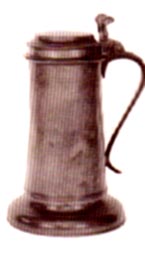 Authentic Beefeater flagon Authentic Beefeater flagon
Methods of manufacture
Most pewter is cast in moulds. These were often made of bronze, but moulds were also made of iron, wood, clay and stone. Simple shapes such as plates and
spoons could be cast in a two-part mould, but complex forms such as tankards or flagons needed multi-part moulds. The various parts of a casting had then to be soldered
together. When a casting came out of the mould it had to be trimmed off and the rough surface polished down on a wheel, using a hard tool or abrasive. Pewterers tended to
complete the undersides of their pieces carefully, using a wheel and turning off the metal in a widening concentric ring. So look for the evidence that the object has been
cast in a mould, not raised over a form or stamped out from sheet metal. Look for quality craftsmanship on the seams and turning. Be skeptical about anything that has not
been turned off on the bottom or under the base.
The styles of pewter
To be able to date pewter you have got to be able to put a provisional period to an object from its appearance. This will not be an exact date, for
stylistic changes did not occur in a smooth, even way, but its shape and appearance ought to suggest to you a likely period in which an object would have been made.
Makers’ and other marks
Fakers and reproduction makers have used “genuine” marks on their work, so a mark by itself is no safeguard. But it is also true that genuine pewter
was often not fully marked, so fine items may lack the proof of who made them. The nature and the size of marks also changed through the ages. Early marks are very simple,
basic shapes with two initials, usually small. They were struck on handles, the front rims of plates, and so on. By the late 18th Century large, complex marks with full names
and even addresses were used and these appear, because of their size, underneath plates. Stuart tankards normally have marks struck either on the lid, if it is flat, or
inside the base. However, during the early 18th Century a secondary system of marking became popular - pseudo hallmarks. These were normally struck four times and they are
useful both to help identify a maker and offer confirmation of the period. It is not possible to establish a set of rules. Makers tended to put their marks where they wanted.
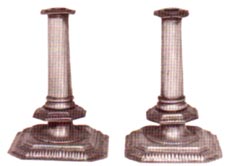 Pair of faked pewter candlesticks
in Charles II style Pair of faked pewter candlesticks
in Charles II style
Other useful marks found on pewter are those placed there by early owners. These ownership marks take unusual forms; a small group of housemarks, made by
the owner, or perhaps the owner’s initials were used. Sometimes when an object was used in a tavern or market, there will be capacity marks stamped into mugs and tankards.
Pewter and brass mugs often have measures stamped on the rim.
The condition of old pewter
Look at every surface of a piece of pewter. How did it get its bumps and dents. Are they consistent with real wear? Fakers tend to bang away without regard
to the way an object is naturally used. A pattern of even wear over the entire surface is unnatural. If it is a plate, is there an irregular pattern of knife cuts, or are
there just a few, evenly marked across the surface? Are the edges, bottom, hinges, and neck of a flagon or tankard worn and soft with use, or are they sharp and even?
Most alloys of tin will oxidize over time but it takes at least 50 years of genuine oxide to develop. Is the oxide where you would expect; in damp parts of
the object, or where it got the least use? Real oxide can erupt into unpleasant bubbles and these are very hard to fake. Likewise, genuine light oxide cannot be copied
properly. Fake oxide is always found with small holes in it rather than rounded eruptions. This is because it was put there with a fine drill and acids, rather than occurring
naturally from within.
Good old days!
Contributed by Lesley Warner, Women’s World
This was passed onto me by a friend - it gave me a lot of laughs and I’m sure will be entertaining for all those ladies that read it. This is an actual
extract from a Home Economics textbook printed in the early 60’s.
The Good Wife Guide
Have dinner ready. Plan ahead, even the night before, to have a delicious meal ready on time for his return from work. This is a way of letting him know
that you have been thinking about him and are concerned about his needs. Most men are hungry when they come home and the prospect of a good meal (especially his favourite
dish) is part of the warm welcome needed.
Prepare yourself. Take 15 minutes to rest so you will be refreshed when he arrives. Touch up your make-up, put a ribbon in your hair and be fresh looking.
He has just been with a lot of work weary people. Be a little gay and a little more interesting for him. His boring day may need a lift and one of your duties is to provide
it.
Clear away the clutter. Make one last trip through the main part of the house just before your husband arrives. Gather up schoolbooks, toys, papers, etc.,
and then run a dust cloth over the tables. During the colder months of the year you should prepare and light a fire for him to unwind by. Your husband will feel he has
reached a haven of rest and order and it will give you a lift too. After all, catering for his comfort will provide you with immense personal satisfaction. Minimize all
noise. At the time of his arrival eliminate all noise of the washer, dryer or vacuum. Try to encourage the children to be quiet.
Be happy to see him. Greet him with a warm smile and show sincerity in your desire to please him. Listen to him. You may have a dozen important things to
tell him, but the moment of his arrival is not the time. Let him talk first; remember his topics of conversation are more important than yours.
Make the evening his. Never complain if he comes home late or goes out to dinner or other places of entertainment without you. Instead, try to understand
his world of strain and pressure and his very real need to be at home and relax. Try to make sure your home is a place of peace, order and tranquillity where your husband can
renew himself in body and spirit. Don’t greet him with complaints and problems. Don’t complain if he’s late home for dinner, or even stays out all night. Count this as
minor compared to what he might have gone through that day.
Make him comfortable. Have him lean back in a comfortable chair or have him lie down in the bedroom. Have a cool or warm drink ready for him. Arrange the
pillow and offer to take off his shoes. Speak in a low, soothing and pleasant voice. Don’t ask him questions about his actions or question his judgment or integrity.
Remember, he is the master of the house and as such will always exercise his will with fairness and truthfulness.
Once he has had a chance to have his evening meal clear the dishes and wash up promptly. If your husband should offer to help decline his offer as he may
feel obliged to repeat this offer and after a long working day he does not need the extra work. Encourage your husband to pursue his hobbies and interests and be supportive
without seeming to encroach. If you have any little hobbies yourself try not to bore him speaking of these, as women’s interests are often rather trivial compared to
men’s.
At the end of the evening tidy the home ready for the morning and again think ahead to his breakfast needs. Your husband’s breakfast is vital if he is to
face the outside world in a positive fashion.
Once you have both retired to the bedroom prepare yourself for bed as promptly as possible. Whilst feminine hygiene is of the utmost importance your tired
husband does not want to queue for the bathroom, as he would have to do for his train. But remember to look your best when going to bed. Try to achieve a look that is
welcoming without being obvious. If you need to apply face cream or hairless wait until he is asleep as this can be shocking to a man last thing at night.
When it comes to the possibility of intimate relations with your husband it is important to remember your marriage vows and in particular your commitment
to obey him. If he feels that he needs to sleep immediately then so be it. In all things be led by your husband’s wishes; do not pressure him in any way to stimulate
intimacy. Should your husband suggest congress then accede humbly all the while being mindful that a man’s satisfaction is more important than a woman’s. When he reaches
his moment of fulfillment a small moan from yourself is encouraging to him and quite sufficient to indicate any enjoyment that you may have had.
Should your husband suggest any of the more unusual practices be obedient and uncomplaining but register any reluctance by remaining silent. It is likely
that your husband will then fall promptly asleep so adjust your clothing, freshen up and apply your nighttime face and hair care products.
You may then set the alarm so that you can arise shortly before him in the morning. This will enable you to have his morning cup of tea ready when he
awakes.
Ah, yes, the good old days - for some!
Copyright 2001 Pattaya Mail Publishing Co.Ltd.
370/7-8 Pattaya Second Road, Pattaya City, Chonburi 20260, Thailand
Tel.66-38 411 240-1, 413 240-1, Fax:66-38 427 596; e-mail: [email protected]
|

The Rotary Club
of Jomtien-Pattaya

Skal
International

Pattaya
Fun City
By The Sea
|